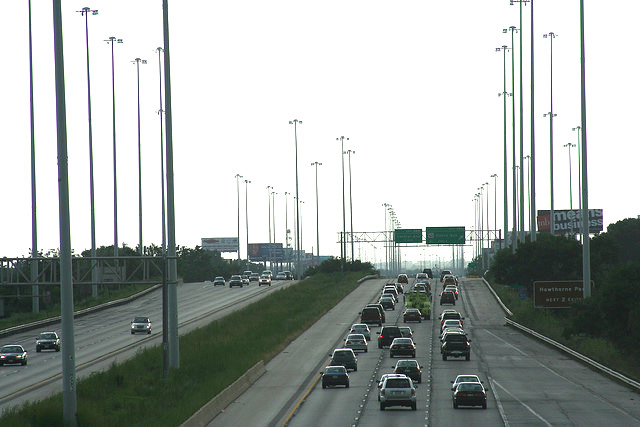As Greater Greater Washington noted, earlier this month a new tolling policy on the crowded 10-mile stretch of I-66 in northern Virginia, inside the D.C. beltway, resulted in sticker shock for drivers. While during peak hours this highway segment had previously been only open to carpoolers, people driving hybrid or electric cars, and folks traveling to Dulles Airport, it was opened to solo drivers who pay a toll.
As required by law, congestion pricing was implemented to maintain 55 mph traffic on the Interstate – as more people enter the highway the toll for single-occupant vehicles goes up, discouraging additional solo motorists from entering. But while officials had projected the tolls would reach about $6, the rush hour rates actually skyrocketed to between $30 and $40 as a result of heavy traffic, although some people are conjecturing that the fee is higher than necessary.
A recent Chicago Tribune editorial argued that we should view this as a cautionary tale as the Illinois Department of Transportation considers widening I-55, aka the Stevenson Expressway, to add tolled express lanes. The current proposal is to add two lanes in each direction on the highway between the Kennedy Expressway junction and I-294, and one line in each direction between I-294 and I-355, the Veteran’s Memorial Tollway.
Under the current plan Pace buses and carpoolers would use the new lanes for free, while solo drivers would pay a toll. IDOT is still considering whether that would be a flat fee or a sliding scale based on the congestion level during rush hours, as in Virginia, to help keep traffic flowing and encourage carpooling and bus ridership.
The Tribune editorial board wrote that it supports the idea of congestion pricing but argued that such high fees would be unfair non-affluent drivers. “A fluctuating premium rate has some appeal — it assures that the express lanes don’t become so crowded as to defeat their purpose. But transportation officials should think long and hard before implementing a pricing system that allows the price of a commute to spike to $40 or higher.”
But GGW’s David Alpert argued that those $40 tolls in Virginia actually reflect the real price of highway transportation, which is largely hidden from the public because gas tax money, along with other kinds of tax revenue, is used by states and the federal government to fund road construction. The Stevenson expansion is supposed to be partly or wholly funded by a developer through a public-private partnership, with the investor getting its money back via toll revenue. But any contract is likely to have safeguards for the developer in case there’s a revenue shortfall, which could leave Illinois taxpayers holding the bag.
It’s true that $40 tolls would likely face a major backlash from Chicago-area drivers. On the other hand, assuming the Virginia fees aren’t artificially inflated, that may be what it takes to limit the number of motorists entering the Stevenson express lanes and prevent them from getting clogged.
Then there’s the whole issue of whether it makes sense to widen I-55 at all, even to make room for tolled, congestion-priced lanes. In a letter to the Tribune last month, Active Transportation Alliance governmental relations director Kyle Whitehead said the group supports setting aside existing lanes for buses and carpoolers, with dynamic-priced tolls for SOVs. But he noted that expanding the Stevenson, as well IDOT’s proposal to widen I-290 and I-294 to add tolled lanes, would only encourage more driving.
“On the surface, it appears widening and extending roads would better distribute traffic,” Whitehead wrote. The problem is that research and experience show that expanding roads in urban areas only makes traffic congestion as bad or worse in the long run by inducing more people to drive, and fewer people to consider alternative modes like public transit.” He added that highway expansion encourages employers to locate workplaces in transit-inaccessible suburbs, making it harder for low-income people to access jobs.
You can tell IDOT what you think of their plans to widen highways via a comment form.





